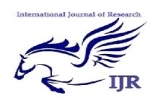Environmental Pollution:- Pollution is the effect of undesirable changes in our surroundings that have harmful
effects on plants, animals and human beings. This occurs when only short-term economic gains are made at the cost of the long-term ecological benefits for humanity. No natural phenomenon has led to greater ecological changes than have been made by mankind. During the last few
decades we have contaminated our air, water and land on which life itself depends with a variety of waste products. Pollutants include solid, liquid or gaseous substances present
in greater than natural abundance produced due to human activity, which have a detrimental effect on our environment. The nature and concentration of a pollutant
determines the severity of detrimental effects on human
health. An average human requires about 12 kg of air each day, which is nearly 12 to15 times greater than the amount of food we eat. Thus even a small concentration of pollutants in the air becomes more significant in comparison to the similar levels present in food. Pollutants that enter
water have the ability to spread to distant places especially in the marine ecosystem.
From an ecological perspective pollutants can be classified
as follows:
Degradable or non-persistent pollutants: These can be
rapidly broken down by natural processes. Eg: domestic
sewage, discarded vegetables, etc.
Slowly degradable or persistent pollutants: Pollutants that
remain in the environment for many years in an unchanged
condition and take decades or longer to degrade. Eg: DDT
and most plastics.
Non-degradable pollutants: These cannot be degraded by
natural processes. Once they are released into the
environment they are difficult to eradicate and continue t
AIR POLLUTION
Air pollution occurs due to the presence of undesirable solid
or gaseous particles in the air in quantities that are harmful
to human health and the environment. Air may get polluted
by natural causes such as volcanoes, which release ash, dust,
sulphur and other gases, or by forest fires that are
occasionally naturally caused by lightning. However, unlike
pollutants from human activity, naturally occurring
pollutants tend to remain in the atmosphere for a short
time and do not lead to permanent atmospheric change.
Pollutants that are emitted directly from identifiable
sources are produced both by natural events (for example,
dust storms and volcanic eruptions) and human activities
(emission from vehicles, industries, etc.). These are called
primary pollutants . There are five primary pollutants that
together contribute about 90 percent of the global air
pollution. These are carbon oxides (CO and CO2), nitrogen
oxides, sulfur oxides, volatile organic compounds (mostly
hydrocarbons) and suspended particulate matter.
Pollutants that are produced in the atmosphere when
certain chemical reactions take place among the primary
pollutants are called secondary pollutants . Eg: sulfuric acid,
nitric acid, carbonic acid, etc.
Carbon monoxide is a colourless, odorless and toxic gas
produced when organic materials such as natural gas, coal or
wood are incompletely burnt. Vehicular exhausts are the
single largest source of carbon monoxide. The number of
vehicles has been increasing over the years all over the
world. Vehicles are also poorly maintained and several have
inadequate pollution control equipment resulting in release
of greater amounts of carbon monoxide. Carbon monoxide is
however not a persistent pollutant. Natural processes can
convert carbon monoxide to other compounds that are not
harmful. Therefore the air can be cleared of its carbon
monoxide if no new carbon monoxide is introduced into the
atmosphere.
Sulphur oxides are produced when sulphur containing fossil
fuels are burnt.
Nitrogen oxides are found in vehicular exhausts. Nitrogen
oxides are significant, as they are involved in the production
of secondary air pollutants such as ozone.
Hydrocarbons are a group of compounds consisting of
carbon and hydrogen atoms. They either evaporate from
fuel supplies or are remnants of fuel that did not burn
completely. Hydrocarbons are washed out of the air when it
rains and run into surface water. They cause an oily film on
the surface and do not as such cause a serious issue until
they react to form secondary pollutants. Using higher
oxygen concentrations in the fuel-air mixture and using
valves to prevent the escape of gases, fitting of catalytic
converters in automobiles, are some of the modifications that can reduce the release of hydrocarbons into the
atmosphere.
Particulates are small pieces of solid material (for example,
smoke particles from fires, bits of asbestos, dust particles
and ash from industries) dispersed into the atmosphere.
The effects of particulates range from soot to the
carcinogenic (cancer causing) effects of asbestos, dust
particles and ash from industrial plants that are dispersed
into the atmosphere. Repeated exposure to particulates can
cause them to accumulate in the lungs and interfere with
the ability of the lungs to exchange gases.
Lead is a major air pollutant that remains largely
unmonitored and is emitted by vehicles. High lead levels
have been reported in the ambient air in metropolitan cities.
Leaded petrol is the primary source of airborne lead
emissions in Indian cities.
Pollutants are also found indoors from infiltration of
polluted outside air and from various chemicals used or
produced inside buildings. Both indoor and outdoor air
pollution are equally harmful.

